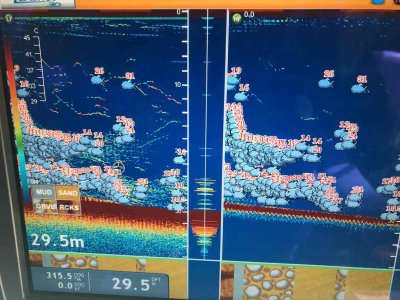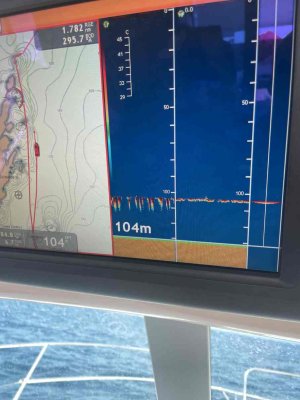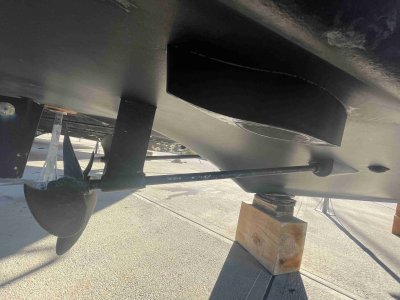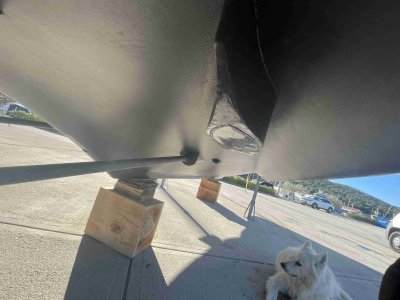Good morning Mvucic,
Thank you for the photos. I can see some things that will need to be changed.
1.) Thank for the reference of the transducer, I was going to say if you are using a B254, that transducer is not compatible for the DFF1-UHD. I can see that you ammended the transducer in use which is a B65. Unfortunately I am not familiar with that transducer and could not find any reference to the transducer on the internet. So question, the photos indicate you are using a chirp transducer, looking at the photos I can tell that the frequency is wired correctly. I can also tell that the it is a low/high transducer because the high frequency bottom tail is much thinner than the low frequency.
Are you using a 1kw bronze thru transducer with fairing block: This would be a B265LH, I believe that is what you meant in your response? Which is good, it is a nice transducer. But we really need to confirm what transducer because the setup of the DFF1-UHD is different with different Chirp Transducers.
We will need to verify some how you have the transducer setup in the MFD12. Since you are familiar with the process, please provide a screen shot of the Fish Finder Setup Screen in the installation Wizard. You mentioned that you removed the Orange Wire, it is now manually set.
If the transducer is a B265LH it is ok to use the TID Wire, but it is also OK to use a manual setup. However, after setting up the transducer in the installation Wizard and you exit the installation wizard. Both the MFD and the DFF1-UHD need to be power cycled, meaning they must have power cut, not just turning them off, but remove power to the units for 5 seconds. You only have to do this after the installation wizard is used.
We need to confirm how the transducer is manually setup in the installation Wizard, please provide a photo.
2.) The Fish Finder Photo 1: The first photo you supplied looks to be in about 30m of water. And the screen is full of Accu-Fish symbols, those symbols in that photo are covering many echoes on the screen. I would advise at this time to turn off the Accu-Fish Symbols at least until we can determine what is going on with your fish finder. I also see plenty of individual echoes, or the streaky lines in that photo. Those streaky lines are fish swimming under the vessel. I know you mentioned you are not seeing fish at 50m, but the first photo is showing plenty of return signals from targets in the water column. Below I circled some fish targets on your display, again the Accu-Fish symbols are masking a lot of those marks, so lets turn them off for now and see what we can see. I also provided a similar picture of some rock fish that show similar marks on the display. This photo was taken fishing for rock fish in Alaska. I also think we could make the fish target returns better by making some adjustments to the settings. I have provide some recommendations below.


3.) Fish Finder Photo 2: This photo is similar to photo 1, it is showing many fish echoes but they are covered by the Accu-Fish Symbol. In order to fully understand what is going on we would prefer to see some photos without the Accu-Fish Symbols until we can better understand the returns from the fish finder. Question: What kind of gain setting was used for these photos: Where you in Auto-Fishing, Auto-Cruising, or Manual Gain? If you where using manual gain, can you remember what the gain value was for both high and low frequency?
In both the first photo and the second photo, the vessel appears to have 0 speed over ground, it looks like you where drifting. That is ok, the return from the bottom on the fish finder is solid without any evidence of turbulence or air bubbles going under the transducer.
4.) Fish Finder Photo 3: In this photo, the bottom is much deeper, around 100m, it also appears that the gain levels could be increased to see more on the screen. Can you remember what the gain settings were in this photo? My guess you where using an Auto Gain Mode, but if you where in manual gain mode, I would try to increase the gain, even if the screen becomes more saturated than you prefer, we need to determine with higher gain values that the fish finder can produce echoes. The other thing I noticed in photo 3, you appear to have forward motion, the vessel is cruising around 6.7 knots. At this speed we are seeing signs of turbulence and bad water flow over the transducer. This is indicated on the low frequency, the bottom is starting to break-up, when the bottom starts to break-up that is an indicator that you are getting bad waterflow over the transducer. When the water flow becomes compromised over the face of the transducer, the performance of the fish finder is decreased dramatically. So we need to identify why we are getting bad water flow and work on ways to improve the water flow when the vessel is cruising in order to improve the fish finder performance at speed. Do you have any photos of the transducer installation on the vessel? We need to try and determine what is causing the turbulence the fish finder is seeing when cruising at speed?
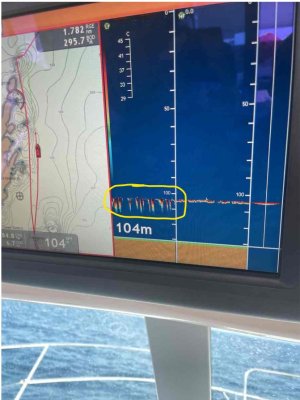
5.) Settings: Based on what I can see in the photos, I think there is hope for you and your system. I don't think anything is broken at this stage but we need to confirm the transducer location on the vessel to see why you are getting turbulence. We also need to confirm the setup of the transducer in the Installation Wizard. The water turbulence over the transducer is negatively affecting the performance, but at slower speeds like photo 1 and photo 2 we are seeing fish returns, they are just masked by the Accu-Fish symbols. I would also like to confirm the settings in the Fish Finder Menu, to make sure that we have all the settings correct to help increase performance. So we will wait to see what settings are being used in the Fish Finder Menu. At this stage I would recommend to turn off the Accu-Fish Symbols. I would also recommend if you are using Auto Fishing or Auto Cruise for your gain settings that we try to manual set the gain to see what you can see on the fish finder. If you are using manual gain, based on the photos I think we need to increase the gain for both high and low frequency. Typically I would set the manual gain by first making sure the clutter control and the Color Erase is set to "0" in the fish finder menu. Then i would start to increase the gain of both frequencies until we start to see some background noise on the fish finder display. The background noise will appear as green/blue speckling. Once you start to see the green/blue speckling you should also be seeing some fish targets or other echoes on the screen. Once we can see that, you can return to the Fish Finder Menu and start to increase the Clutter setting, increase the clutter setting until some of the blue/green back ground noise speckles start to disappear. If you can do this on your next fishing trip and take some photos of the fish finder screen that will help us determine where we need to go next. But we still need to figure out the water flow issue, bad water flow is eliminate fish targets or any chance for the fish finder to see fish targets.
Some of the other settings in the Fish Finder Menu that I would choose:
Picture Advance: 1/1
Interference Rejection: Set to Off, unless you see signs of interference from another fish
finder on the boat or around you.
Clutter: Start at "0", then increase the value until the background noise starts to fade.
This can only be done in Manual Gain control. Depending on the
amount of gain used this value will likely be somewhere between 20-
30.
Color Erase: Keep at "0"
White Marker: Off
TVG High: 5
TVG Low: 5
Transmit Rate: The highest value available, 20.
In the System Menu, make sure the fish finder transmit power is set to 10, if 10 is not available, then choose the highest value, this may be Auto for the DFF1-UHD.
Please try the recommendations on your next fishing trip and take plenty of photos to provide more information.
Kind Regards,
C-Bass


